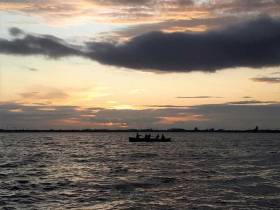Displaying items by tag: Hobblers
St. Michael’s Rowing Club will host The Hobblers Challenge on the 7th of September. The challenge is a 28km endurance coastal rowing race, which has been taking place since the 1990s on Dublin Bay.
Several courses have been used, predominantly from Dún Laoghaire Harbour to the Kish Lighthouse and back.
Four categories will compete this year: Ladies, Men, Mixed and Under 21.
The current course, set in 2017, starts at Dun Laoghaire Harbour, at the East Breakwater beneath the Hobblers Memorial, out the harbour mouth, around the landward side of a ‘gate boat’ off Merrion Strand, around Poolbeg Lighthouse, up the Liffey as far as the ESB towers, before doubling back, across the mouth of Dun Laoghaire Harbour, across Scotsman’s Bay, past Sandycove and Bullock Harbours, turning at Coliemore Harbour, before returning to Dun Laoghaire Harbour, finishing at the end of the East Breakwater.
“We are delighted to host this endurance race again. Similar to previous years, the competition is open for traditional skiffs so we are hoping to get as many East Coast rowing clubs taking part as possible,” said James Tedd, St. Michael’s Club Chairperson and race organiser.
Participants can choose between four categories: Ladies, Men, Mixed and Under21. “The latter two are an addition to the 2018 race,” explained Eoin Clarke, Race Registration Officer. “ We aim to be inclusive to experienced rowers of all ages, and we hope that, by introducing the Under21 category, we can help young rowers who transition from the youth level to the adult one get a taste for what endurance racing is, by competing against rowers of the same age. ”
The best times to complete the challenge are 2h47min - a record held by the St. Michaels’ men 2018, and 3h 3min - a record held by the St. Michaels’ ladies. Both records were set in 2018.






























































